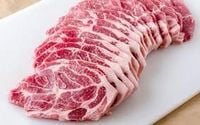In a striking turn of events, the UK beef and lamb markets are experiencing significant shifts in both import and export dynamics as 2025 unfolds. The latest data reveals a dramatic decline in beef imports from Germany, coupled with a notable increase in imports from Australia, while the country grapples with rising food inflation.
According to recent reports, UK beef imports from Germany plummeted by a staggering 81% in the first two months of 2025, dropping from 1,200 tons to just 200 tons. This sharp decline is largely attributed to the ongoing foot-and-mouth disease outbreak in Germany, which has severely restricted the availability of beef imports from the country. In contrast, imports from Australia surged by 144%, totaling 1,200 tons, with a remarkable 95% of this being fresh or chilled boneless beef. This shift indicates a significant change in sourcing for UK beef, as the country looks to Australia to fill the gap left by reduced European imports.
In March 2025 alone, nearly 700 tons of Australian beef entered the UK market, of which 57% was chilled grain-fed beef. The increase in Australian beef imports has been particularly notable in various cuts, with significant rises in the import of tenderloin (up 97%), brisket (up 87%), and striploin (up 100%). This influx of Australian beef highlights a growing reliance on non-European sources as the UK navigates the complexities of its trading relationships.
On the export side, however, UK beef faced challenges as exports decreased by 12% in the first two months of 2025, totaling 20,600 tons. Despite this drop in volume, the value of beef exports rose by 12%, reaching £110 million. This increase in value can be attributed to higher prices for British beef, which have outpaced those of continental counterparts. France remains the most lucrative market for UK beef, with a 17% increase in value to £34 million, although exports to key markets such as Ireland and the Netherlands have declined due to the price disparity.
Meanwhile, the UK lamb market is also witnessing changes. Lamb imports surged by 12% compared to 2024, and by 59% compared to 2023, reaching 11,500 tons in the first two months of 2025. The majority of these imports came from New Zealand and Australia, with 7,000 tons and 2,800 tons, respectively. In March 2025, imports from Australia alone reached 2,700 tons, marking the highest volume since December 2024. Conversely, lamb imports from Ireland fell by 23% to 1,500 tons, likely due to significant price differences.
Despite the fluctuations in imports, lamb exports remained relatively stable at 14,000 tons, reflecting a slight decrease of 0.9% compared to the previous year. However, the value of these exports rose by 12% to £102 million, indicating strong demand despite higher domestic prices.
As the beef and lamb markets adjust, another pressing issue looms over the UK: food inflation. In April 2025, food inflation reached an 11-month high, with prices increasing by 2.6% compared to March, which saw a 2.4% rise. This increase marks the highest rate of inflation since May 2024, according to the British Retail Consortium (BRC). Fresh food prices rose by 1.8% year-on-year, surpassing the previous month's 1.4% and the average of 1.5% for the first three months of the year. Additionally, prices for food that can be stored at room temperature increased by 3.7%, remaining unchanged from the previous month but higher than the three-month average of 3.4%.
Helen Dickinson, the CEO of BRC, highlighted that essential items like bread, meat, and fish have seen price increases, driven by rising retail costs. This situation follows the announcement of a higher national insurance tax for employers, which came into effect in April, prompting many businesses to consider cutting jobs and raising prices to offset increased costs.
The Bank of England (BoE) has noted that food inflation at the beginning of 2025 exceeded expectations, influenced by domestic factors such as rising labor costs, alongside external shocks. The impact of rising food prices is felt most acutely by low-income families, who allocate a significant portion of their income to essential goods.
Looking ahead, the UK economy is projected to experience slow growth over the next two years, with the EY Item Club forecasting only a 0.8% increase in GDP for 2025, down from an earlier estimate of 1%. The forecast for 2026 has also been revised down from 1.6% to 0.9%, reflecting long-term impacts on the UK economy.
In a separate survey, Ipsos reported a significant drop in confidence in the UK economy, with three-quarters of respondents expecting economic conditions to worsen in the coming year. Only 7% believe the economy will improve, while 13% anticipate no change. This pessimism is compounded by global trade tensions, particularly those stemming from tariffs imposed during Donald Trump’s presidency, which have constrained consumer spending and business investment.
With approximately 16% of UK exports heading to the US, where a basic 10% import tariff is applied, the situation poses direct challenges to growth by reducing demand for British products. Many UK businesses are now seeking to mitigate these challenges by exploring new export markets in Asia, Africa, and Australia. A recent survey by BDO revealed that nearly 30% of mid-sized UK firms prioritize expanding or exporting abroad in 2026, with over 50% of retail, wholesale, and technology businesses anticipating increased exports next year.
As British exporters aim to strengthen their foothold in international markets, the focus remains on re-engaging with EU countries, with 41% of mid-sized firms targeting increased sales to EU member states. Richard Austin, a partner at BDO, emphasized that despite the ongoing challenges, UK businesses are ambitious and committed to driving growth.




